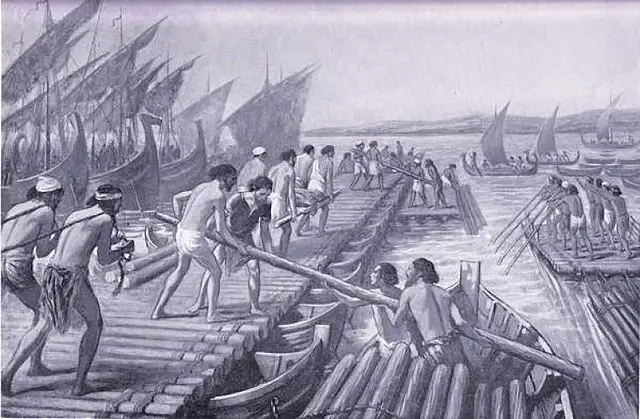Picture this: a god-king in silk robes, staring at the roaring waves of the Aegean Sea, shaking with fury. His bridge has just been wrecked by a storm. What does he do? Build another one? Retreat? Nope. He orders his soldiers to whip the sea. Yes, literally.
A God Among Men
Xerxes I, king of the Persian Achaemenid Empire, was not a man used to being told “no.” His father, Darius the Great, had tried (and failed) to conquer Greece. Xerxes inherited not just the throne, but also the grudge.
By 480 BCE, Xerxes was done with threats and skirmishes. He wanted Greece crushed under his golden sandals. He assembled the largest army the world had seen at that point—some say over two million, though historians argue those numbers. Regardless, it was big enough to feel like the earth shook when it moved.
But to get this army into Greece, Xerxes needed a shortcut. The Hellespont, a narrow stretch of sea between Asia and Europe, stood in the way.
The First Bridge Fails
Xerxes ordered a pontoon bridge, basically floating ships tied together with planks laid across. Two of them, actually. Built with Egyptian flax and papyrus ropes. It was a marvel of ancient engineering.
And then the sea had the audacity to have a storm.
The whole thing was destroyed. Just ripped apart.
Now, most people would blame the weather and try again, maybe mutter a few curses under their breath.
Not Xerxes.
He didn’t just take it personally. He went full tyrant tantrum.
The Sea Gets a Beating
Herodotus tells us that Xerxes, enraged, ordered his soldiers to punish the sea. They whipped it 300 times. They branded it with hot irons. They shouted at it.
The actual words, according to ancient texts, were something like: “You salt and bitter sea, your master has condemned you to suffer this punishment for wronging him without cause.”
Imagine being the guy in the front row assigned to yell at a wave. What do you even say?

Theater or True Madness?
It sounds absurd now, and maybe it was absurd then. But Xerxes wasn’t just throwing a fit. At least, not entirely. In the ancient world, rulers often acted like gods. Divine right wasn’t just a phrase; it was policy. By punishing the sea, Xerxes was reminding everyone, his army, his enemies, maybe even himself, that he ruled not just people, but nature itself.
It was psychological warfare, myth-making, and political theater rolled into one very wet, very dramatic episode.
Round Two: The Successful Bridge
After the whipping, Xerxes had his engineers try again. This time, they got it right. More ships, sturdier ropes, better timing. The new bridges held.
His massive army crossed into Europe, beginning the infamous second Persian invasion of Greece.
You know what came next: the battles of Thermopylae, Salamis, and Plataea. The Spartans, the phalanxes, the legendary stand of King Leonidas. That part of the story gets all the movie deals.
But this moment with the sea? It was the opening act. A strange, telling prelude to everything that followed.
Control Issues, Much?
Let’s be real. Whipping the ocean won’t make it behave. But Xerxes didn’t care about logic. He cared about control. The bridge wasn’t just wood and rope. It was a symbol of dominance, his will imposed on the wild.
There’s something weirdly relatable in that. Haven’t we all tried to control things beyond us? The weather. Other people’s opinions. Our lives. It usually goes about as well as yelling at the tide.
But hey, at least we don’t whip puddles when we’re mad. (Most of us.)
Did It Actually Happen?
Good question. Herodotus, our main source, was known to mix facts with flair. He wrote decades after the events, and even his fans call him the “Father of Lies” sometimes.
So maybe Xerxes didn’t literally brand the sea. Maybe it was symbolic. Or exaggerated. Or even propaganda meant to show how terrifying and powerful the Persians were.
But even as a legend, it stuck. And that tells us something.
Power and the Performance of It
What Xerxes did, or was said to have done, shows how ancient leaders used symbolism as strategy. They didn’t just lead armies. They crafted images of themselves as larger-than-life. Untouchable. Godlike.
In that light, punishing the sea wasn’t about anger. It was about spectacle.
Think of modern leaders who stage dramatic events for cameras. Military parades. Flag plantings. Everything meticulously planned to show who’s in charge. Xerxes was just… earlier.
Waves Don’t Listen
In the end, the sea didn’t change. It just kept doing what seas do. Crashing, flowing, defying control.
Xerxes crossed it, yes. But he never conquered it.
And maybe that’s the real story here. The sea became a symbol of something Xerxes couldn’t bend. He ruled millions, but not the wind.
For a man who demanded obedience from everything in his path, that must have been maddening.
The Aftermath
The war didn’t go Xerxes’s way, long term. Despite early victories, his forces were eventually driven out of Greece. His grand invasion sputtered. His navy was defeated. He returned home, his ego a bit more bruised, his god-king image cracked.
But the bridge? That worked. The sea let him cross. And that small victory, born of engineering, defiance, and yes, even madness, became one of the strangest footnotes in military history.
Why It Still Matters
It’s easy to laugh at the idea of an emperor whipping the ocean. But there’s something poetic about it, too.
It’s a story about the limits of power. About the drama of leadership. About how even the most powerful people can be brought to rage by things they can’t control.
And, perhaps, about the quiet stubbornness of nature. No matter how many times it gets shouted at, it just keeps rolling in.
In the end, Xerxes taught us a strange, unforgettable lesson: You can build bridges, command armies, and name yourself king of kings. But the sea doesn’t care.
It never did.
Sources:
1. Herodotus – Histories
2. worldhistory.org – Xerxes I
3. Britannica – Xerxes I
4. livius.org – Xerxes I

